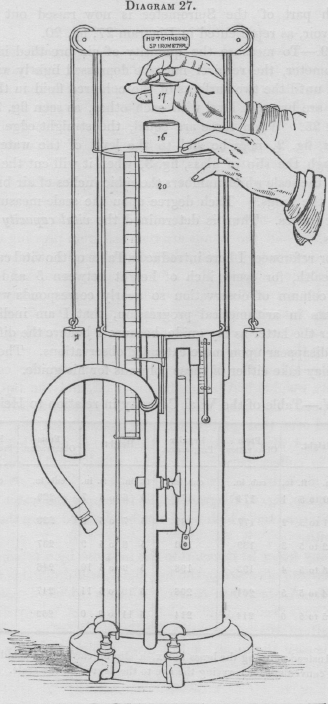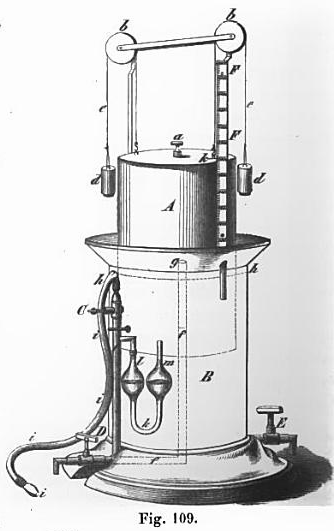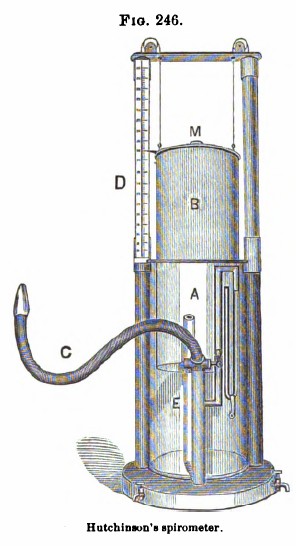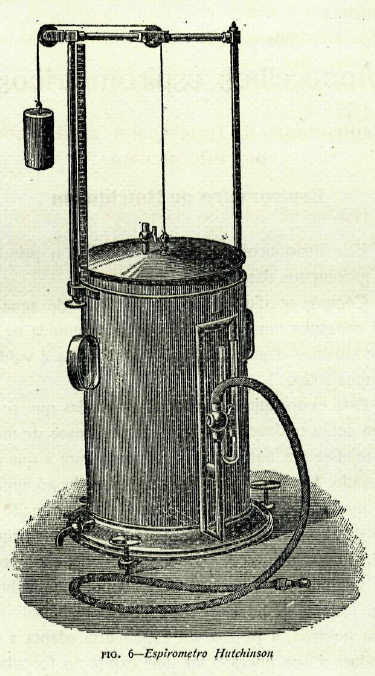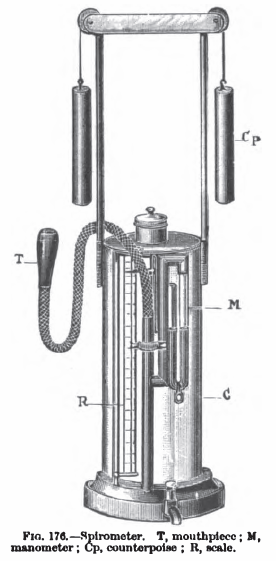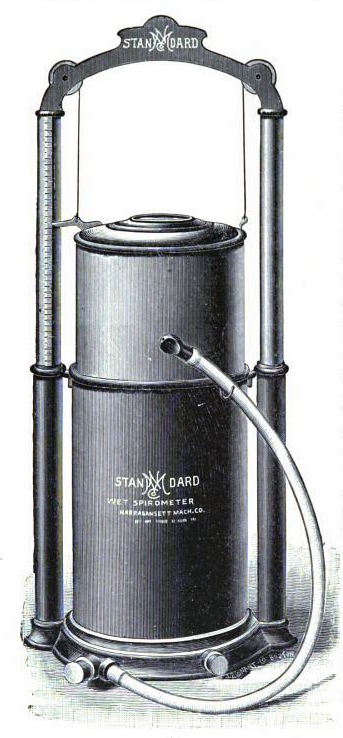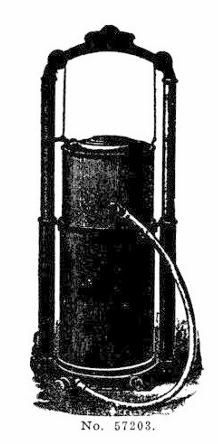John Hutchinson presented his spirometer in 1846. Although he coined the word “spirometer” it was based on the gasometer invented by James Watt in 1790. The Hutchinson spirometer was a precision instrument and in its construction he appreciated the effect that pressure and temperature have on measuring air volumes. On the side of the spirometer was a U-tube manometer that was used to adjust the spirometer’s counterweights so that the pressure inside the spirometer was the same as outside. A thermometer was also mounted on the side so that temperature corrections could be made.
The Hutchinson spirometer was manufactured by various individuals, workshops and companies virtually unchanged for well over a half a century. A signature aspect of the Hutchinson spirometer are the twin pulleys and counterweights.
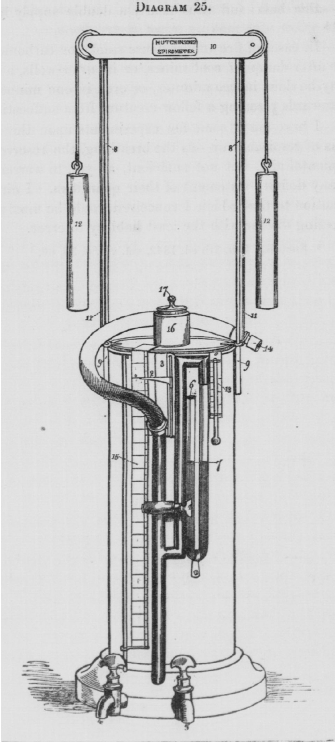 Hutchinson Spirometer, 1846. From: Hutchinson J. On the capacity of the lungs and on the respiratory functions, with a view of establishing a precise and easy method of detecting disease by the spirometer. Med Chir Trans 1846; 29: 137-252.
Hutchinson Spirometer, 1846. From: Hutchinson J. On the capacity of the lungs and on the respiratory functions, with a view of establishing a precise and easy method of detecting disease by the spirometer. Med Chir Trans 1846; 29: 137-252.
Hutchinson Spirometer, 1846. From: Hutchinson J. On the capacity of the lungs and on the respiratory functions, with a view of establishing a precise and easy method of detecting disease by the spirometer. Med Chir Trans 1846; 29: 137-252.
“To measure the quantity of air breathed into the spirometer, the receiver must be depressed lightly with the hand until the two surfaces of the coloured fluid in the bent tube are brought level with each other, as seen in Fig 7, diagram 25. When these are equal, the straight edge of the index, fig 2., may be slid to the level of the water as seen through the slip of glass, fig 8, when it will cut the degree upon the scale which numbers the cubic inches of air breathed from the lungs. Each degree upon the scale measures two cubic inches. This is determined the vital capacity of the lungs.”
Hutchson Spirometer, 1859. From: Physiologie des Menschen. By Franciscus Cornelis Donders and Antonius Franciscus Bauduin, 1859, page 410.
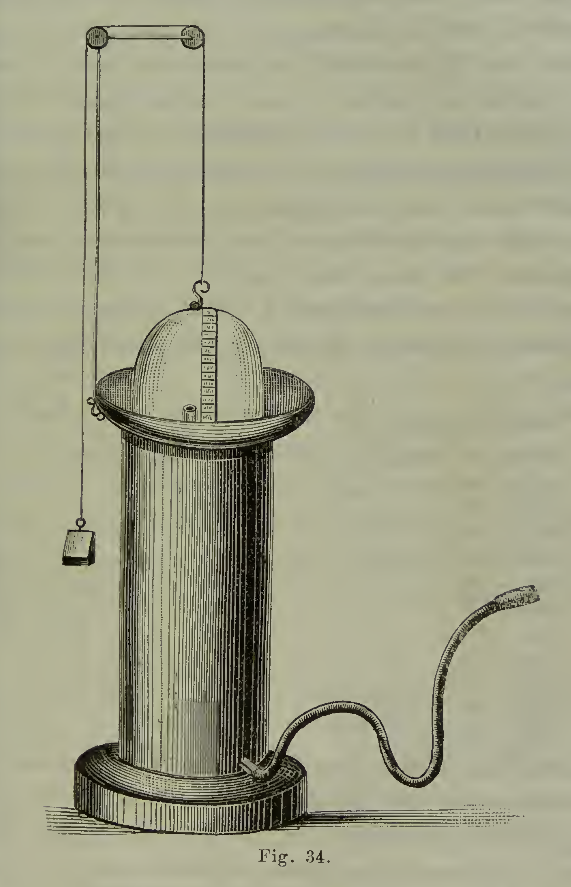
Hutchinson Spirometer, 1876. Although quite different than Hutchinson’s original design, this spirometer was attributed to him in ‘Handbuch der pneumatischen therapie’, by Dr. Theodore Knauth, published 1876, page 293. The fact that it was a counter-weighted spirometer was noted in particular.
Hutchinson Spirometer, 1879. From: George Tiemann and Co. Catalog, The American Armamentarium Chirurgicum, 1879, page 98.
Hutchinson Spirometer, modified by Hawksley, 1887. From Treatise on human physiology by Henry Cadwalader Chapman, Published by Lea Brothers & Co, 1887, page 430.
“The instrument described by Hutchinson, and somewhat modified by Hawksley for the author, consists (Fig. 246) essentially of a cylindrical vessel (A), with a capacity of about 7.5 liters (2 gal.), containing water, out of which a receiver (B) can be elevated and depressed by breathing into it through a tube (C), and then the height to which the receiver is elevated and depressed, as shown by the scale D indicating the volume of air expired and inspired. In using the spirometer, it should be placed upon a firm, level table, about three feet from the ground. The water tap then having been turned off, and the air tap opened, clear, cold water is poured through the spout of the cylindrical vessel A, until it is full, any excess of water running off by the tap in communication with the air tube. Enough colored spirit is poured into the U-shaped tube, until it stands about 3.5 inches. The counterpoising weights being then suspended within the framework M, and over the pulleys, and the air tap closed, the instrument is ready for an observation. The person whose breath capacity is to be determined standing erect with head through backward, and loosely attired, applied by the mouth-piece the flexible tube C to his mouth and expires into the spirometer. The air from his lungs passes thence into tube E, elevating the receiver B, by the volume of air expired, expressed in cubic inches, being shown bu the number of the scale to which the index connected with the receiver has been elevated. At the termination of the expiratory effort, the air-tap must be closed.
Hutchinson Spirometer, 1894. From: A Text-book of Pathology: Systematic & Practical, Volume 2, Part 1, by David James Hamilton, 1894, page 50.
“Means of measuring the Vital Capacity – Hutchinson Spirometer.
“This instrument consists of a vessel containing water, out of which a receiver is raised by breathing into a tube; the height to which the receiver is raised indicates the volume of the vital capacity.
“To prepare the instrument for use.
“(1) Place the instrument about three feet from the ground on a firm, level table.
“(2) Turn off the water tap (fig. 235, 4) and open the drain tap (5) seen at the bottom of the spirometer.
“(3) Pour water into the spout at the back until it rises behind the slip of glass (3) placed above the air tube.
“(4) Slide the movable index (2) opposite zero on the scale and add water until it is exactly level with the straight edge of this index. Should too much water already be poured into the spirometer, draw off by the tap (4) sufficient to bring the water down to the edge of the index.
“(5) Pour a little colored spirit into the bent tube (6) until it rises in the two legs of this tube about 3-1/2 inches (7).
“(6) Fix the rods (8) into the sockets (9) on each side at the top of the spirometer.
“(7) Place the cross-head (10) upon these rods, so that the name of the instrument faces the operator; then pass the two red cords (11, 11) over the pulleys at each end of the cross-head.
“(8) Turn off the taps (5 and 1), then suspend the counterbalance weights (12, 12) to the red cord.
“(9) Screw the flexible tube (14) on to the extremity of the air-tube above the tap (1).
“(10) The small thermometer (13) may either be attached to the spirometer on the little hook above 13, or, which is better, hung up in any convenient corner of the room.
“The spirometer is now ready for making an observation”
Hutchinson Spirometer, 1905. From: Anthropometry and physical examination: A book for practical use in connection with gymnastic work and physical education, By Jay Webber Seaver, 1905. Page 25.
Hutchinson Spirometer, 1910. From Espirometria en tuberculose, by A J P Vilela, published 1910, page 72.
Hutchinson Spirometer, 1910. From: Practical Physiology, Edited by M.S. Pembrey, Published by Longmans, Green and Co., NY, 1910, page 178.
Hutchinson Spirometer, 1912. From: Manual of Practical Physiology: Designed for the Physiological Laboratory Course in the Curriculum of the American Association of Medical Colleges, By John Conrad Hemmeter, 1912, page 117. An actual photograph instead of a drawing!
Hutchinson Spirometer, Narraganasett Machine Company, 1916
From: Catalogue of Gymnastic Equipment, Narraganasett Machine Company, 1916, page 152.
“The wet spirometer is generally admitted to be the only device for measuring lung capacity that will continue to record accurately. There is no rubber reservoir to leak or harden and crack in two or three years; an air cylinder immersed in water never leaks or wears out. The air cylinder is made of sheet zinc, and as it is made on an arbor they are exactly the same size and capacity, and record accurately their cubic contents. This cylinder is carefully balanced by weights that run in the tubes at the sides. The side tubes are polished brass and one of them is graduated to measure the height, and consequently the volume contained in the cylinder. One side of the tube is graduated to cubic inches, the other to cubic decimeters. The stopper at the left lets the air out of the cylinder for it to descend, and that at the right has has been replaced by a valve to let the water out of the tank. All parts except the brass tubes are finished in white. It has a capacity of 400 cubic inches or 6.5 cubic decimeters (liters).
A convenient shelf is made to hold the spirometer when no other support is available.
No. 595. Wet Spirometer. Weight 25 pounds. Packed for shipment.”
Hutchinson Spirometer, Stoelting Apparatus, 1930
From Stoelting, C. H. 1930. Apparatus, Tests and Supplies for Psychology, Psychometry, Psychotechnology, Psychiatry, Neurology, Anthropology, Phonetics, Physiology, and Pharmacology. Chicago. Page 212.
Described as a “Spirometer, Wet, Hutchinson’s. Used to measure the total quantity of air that can be forcibly expired after a maximal inspiration. It is calibrated in cubic decimeters and cubic inches and can be used with either glass or wood mouthpieces.”
The picture looks identical to that used in textbooks from around 1900. The Hutchinson spirometer lives on virtually unchanged almost 90 years after it was first invented!

PFT History by Richard Johnston is licensed under a Creative Commons Attribution-NonCommercial 4.0 International License.
